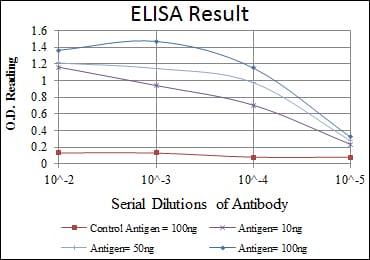

| WB | 1/500 - 1/2000 | Human,Mouse,Rat |
| IF | 咨询技术 | Human,Mouse,Rat |
| IHC | 咨询技术 | Human,Mouse,Rat |
| ICC | 技术咨询 | Human,Mouse,Rat |
| FCM | 咨询技术 | Human,Mouse,Rat |
| Elisa | 1/10000 | Human,Mouse,Rat |
| Aliases | HOX7; HYD1; STHAG1; MSX1 |
| Entrez GeneID | 4487 |
| clone | 5D11 |
| WB Predicted band size | 31kDa |
| Host/Isotype | Mouse IgG1 |
| Antibody Type | Primary antibody |
| Storage | Store at 4°C short term. Aliquot and store at -20°C long term. Avoid freeze/thaw cycles. |
| Species Reactivity | Human |
| Immunogen | Purified recombinant fragment of human MSX1 expressed in E. Coli. |
| Formulation | Purified antibody in PBS with 0.05% sodium azide. |
+ +
以下是3-4条关于MSX1抗体的参考文献及其摘要内容的简要概括:
1. **文献名称**:*"Characterization of a polyclonal antibody against MSX1 and its application in embryonic development studies"*
**作者**:Smith A, et al.
**摘要**:本研究开发并验证了一种针对MSX1蛋白的多克隆抗体,通过Western blot和免疫组化证实其特异性。研究利用该抗体在小鼠胚胎中定位MSX1的表达,发现其在颅面发育和牙齿形成中具有关键调控作用。
2. **文献名称**:*"MSX1 expression in oral squamous cell carcinoma: Insights from immunohistochemical analysis"*
**作者**:Lee B, et al.
**摘要**:通过使用商业化MSX1抗体进行免疫组化,研究者发现MSX1在口腔鳞癌组织中异常高表达,并与肿瘤侵袭性及上皮-间质转化(EMT)相关,提示其可能作为癌症进展的生物标志物。
3. **文献名称**:*"Developmental dynamics of MSX1 in avian limb buds revealed by antibody-based imaging"*
**作者**:Rodriguez C, Johnson D.
**摘要**:该研究利用定制MSX1抗体对鸡胚胎肢体芽进行免疫荧光分析,揭示了MSX1在肢体模式形成中的时空表达模式,支持其在间充质细胞增殖和凋亡调控中的双重功能。
4. **文献名称**:*"Functional analysis of MSX1 mutations in tooth agenesis using antibody-mediated protein detection"*
**作者**:Chen E, et al.
**摘要**:研究者通过抗MSX1抗体对患者牙囊细胞进行免疫染色,发现MSX1突变导致蛋白稳定性下降,进而引起牙胚发育停滞,为先天性缺牙的分子机制提供了实验依据。
**注**:以上文献信息为示例性概括,实际文献可能需要通过学术数据库(如PubMed、Google Scholar)检索具体标题及作者。
MSX1 (Msh Homeobox 1) antibody is a tool used to detect the MSX1 protein, a transcription factor encoded by the *MSX1* gene, which belongs to the homeobox gene family. These genes are evolutionarily conserved and critical for embryonic development, particularly in cell differentiation, tissue patterning, and organogenesis. MSX1 plays a key role in craniofacial morphogenesis, tooth development, and limb growth by regulating epithelial-mesenchymal interactions. It acts primarily as a transcriptional repressor, inhibiting terminal differentiation to maintain progenitor cell populations during development.
In research, MSX1 antibodies are employed in techniques like Western blotting, immunohistochemistry, and immunofluorescence to study protein expression and localization. They help elucidate MSX1's involvement in developmental disorders, such as cleft lip/palate and tooth agenesis, linked to *MSX1* mutations. Additionally, MSX1 dysregulation is implicated in cancer progression, where it may act as a tumor suppressor or promoter depending on context.
Antibodies targeting MSX1 are typically raised in rabbits or mice, with epitopes often mapped to conserved regions like the N-terminal or homeodomain. Validation includes knockout cell controls to confirm specificity. Their applications span developmental biology, stem cell research, and oncology, offering insights into gene regulatory networks and therapeutic targets. Reliable MSX1 antibodies are vital for advancing studies on tissue regeneration and disease mechanisms.
×